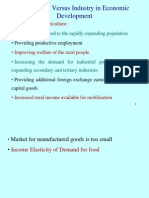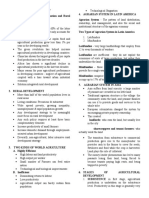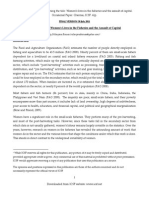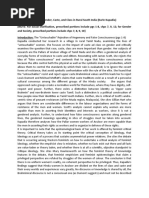Agricultural Development in Monsoon Asia: 1. Engel's Law
Uploaded by
Cherrie DEE GonzalesAgricultural Development in Monsoon Asia: 1. Engel's Law
Uploaded by
Cherrie DEE GonzalesThe tendency for agriculture’s share of income to fall can also demand for agricultural products as living standards
be explained by 2 additional powerful effects: improved in cities.
This pattern of productivity growth in agriculture is
1. Engel’s Law significantly different from that observed in Latin
Low-income elasticity of demand for agricultural America and Africa.
products
As Income increases, a smaller proportion of this is
increase in income is spent on agricultural products. Agricultural Development in Monsoon Asia
Since demand grows slowly, the sector lags behind Monsoon weather cycle in Asia led to reliance in rice
the rest of the economy production
This decreasing domestic demand is unlikely to be Traditional was practiced post-war required more
made up by foreign trade growth because of the Engel intensive
effect also apply internationally manpower specially during planting and harvesting.
Agriculture’s share in world trade has also diminished In between planting and harvesting farmers had to
over time. seek
employment elsewhere.
2. Given that demand is sluggish because of the Engle Opportunity cost of labor is high during planting and
effect, if productivity increases in agriculture is relatively harvesting,
strong, then it is likely that the term of trade for industries cannot hire full-time employees due to the
agriculture in international markets will begin to decline. intermittent demand for labor.
This tendency has been reflected by a downward trend in LFR Model suggest that the opportunity cost of labor
primary product prices for many years. shifting from agriculture to industry was zero.
In Asia, Green Revolution, which occurred at the (However, did not necessarily hold true for Asia)
beginning of the industrialization movement in 1960s, Rice yields per hectare are much higher than for other
further contributed to the decline in Agriculture by grains, and it requires more intensive manpower
increasing agricultural productivity quite substantially. which later on became a major reason that population
This facilitated and accelerated the migration to urban densities are much higher in many parts of Asia.
areas where rapidly growing industrial establishments As a result of intermittent nature of workforce
required more workers. availability, the industries that developed in the rural
areas were also small and labor-intensive.
Productivity in Agriculture Asian villages were densely populated and surrounded
Timmer (1991) : Agricultural productivity growth is by small family farms complemented by small and
generally higher than that of industry at the beginning flexible labor-intensive workshops and factories, often
of the process when industry is still weak and in need employing women and men.
of protection from foreign competition. This was typical situation in peasant agriculture at the
The early phases of industrial development are thus beginning of the postwar era. There was literally no
characterized by a wide productivity gap between scope for increasing agricultural productivity within
agriculture and the rest of the economy. the limitations of traditional farming technology.
The opportunity cost of this labor was high,
Timmer attributes the sectoral differences in the particularly during the planning and harvesting
season. The opportunity cost was not zero as
average productivity of labor to differences in the
suggested by LFR model.
production function and technological change. More
importantly, however, he points out that such
differences may also arise from the low mobility of How did the shift from agriculture to industry take
resources, condition that underlies the persistenceof a place in Asia?
disequilibrium state, such as surplus labor in
agriculture and other low productivity activities, Two keys: Irrigation and higher-yielding varieties.
including handicrafts and services.
It is the surplus from this increase in profitability of The agricultural surplus was important because:
agriculture that serves to fuel the beginning of the 1. It give farmers more income to buy consumer goods
industrialization process. 2. Permitted some workers to migrate to cities to work
in newly established industries without diminishing
Often, in countries where there are wealthy landlords,
overall agricultural output
such as the Philippines, this agricultural surplus is also
the source of a burgeoning industrial empire, as
entrepreneurs make the switch from agricultural Added income is used to adopt more labor-saving
processing to manufacturing. harvesting and cultivation techniques.
However, because of the rapid growth and dynamism
The Efficiency of Traditional Agriculture
of the industrial sectors, this was not necessarily true
in Asia in the 1960s and 1970s. Dates back hundred years or more ago
o Antiquated methods of cultivation
Agricultural productivity growth was also very high in
richer countries of the region such as Korea and o Trial and error
Japan. Many improvements in economic efficiency made
o This is one reason that the industrialization recently in traditional agriculture could not have
experience that began in Japan and occurred without some change in technology or
continued after the war in east Asia, in Korea improvement in irrigation.
and Taiwan, served as a model for the
development in other regions. Studies in determining if traditional agriculture was efficient
In any case, there was a mutual reinforcing interaction (an Indian experience)
between agriculture and manufacturing in Asia.
1. Cobb-Douglas production Function
This was the result of combination of the technology
o Variable factors of production are efficiently
associated with green revolution raising output and
the rapid rate of rural to urban migration that reduced allocated.
population pressure in country side but also raised o Biological assets were not efficiently
allocated.
o This is due to lack of economies of scale
o Greater efficiency could be attained of The aim is to translate the inputs of land, labor,
bullocks were shared among farmers, or if fertilizer, pesticides, irrigation, and mechanization into
the farm size was large enough to effectively higher level of output.
utilize these work animals. This process will depend upon the size of the holding
and the fertility of the soil, weather conditions,
2. Econometric Model susceptibility to flooding and/or drought, potential for
o All resources were allocated efficiently natural disasters, land tenure arrangements,
availability of storage and marketing, transfer of
3. Linear Programming technology through an agricultural extension system,
o The potential output of agriculture was and so on.
higher than the actual output.
o There are inefficiencies but these could be
removed by improving copping patterns. Green Revolution
o Tentative conclusion: Traditional Agriculture- was the phenomena created by the development of
Efficient but minor improvements could be new higher-yielding varieties of rice at the
made. International Rice Research Institute, located in Los
Banos, near Manila, in the Philippines.
The advances made in wheat cultivation were adapted
Why do Peasant Farmers Resist Innovation and to lesser extent, because wheat is heavily grown only
Modernization? in the
more temperate areas of Asia. The results of the
Studies have shown that various innovative Green Revolution on rice production are evident from
approaches to farming and great improvements in the research conducted by Mellor and Mudahar
technology are the key elements to these increases in This study broke down rice production growth into
productivity. several components, including area effects from
Leaving our comfort zone is never easy because of greater irrigation, and yield effects from fertilizer and
Possible uncertainties we may Encounter as we move new technology.
to our zone!
Explanations: What really worked?
1. we note that subsistence farming is the m a in
economic activity for about 80 percent of the rural Application of Fertilizers, pesticides and herbicides
sector in developing countries. Traditional farming Irrigation
systems in many societies define the role of Green Revolution
individuals in the family. All family members interact
and socialize in the process. In such a scenario, the What factors have not helped much?
adoption of new technology or new varieties of seeds Farm size
would not just increase yield. It could also be seen as o There is an inverse relationship between
a mechanism for altering the way of life for many farm size and overall farm productivity in
rural families. traditional agriculture.
2. fact that change may be accompanied by o Inverse relationship disappears with the use
uncertainty. Even if farmers have been assured of a of farming intensity, land quality, use of
strong prob ability of achieving higher yields, they irrigation and technology.
will continue to ask: "What if it fails?" This question Changes in land tenure
assumes greater importance to subsistence farmers o Tenancy arrangement- operated farms
(compared with those that are relatively better off) √ Farmers give the landlord a share of
because failure of the new technique or new seed their harvests.
variety can have disastrous consequences. √ Landlord rents out his land to farmers at
a fixed rate.
o Subsistence agriculture is thus a highly risky o In countries where land distribution is an
and uncertain venture because human lives issue programs on land redistribution is
and people's futures are a t stake. In such advocated on equity grounds.
circumstances where threats of starvation
are real, the main objective of the farmer is
not to maximize income, but to maximize his
family's chances of survival.
o Accordingly, when risk and uncertainty are
high, a small farmer may be very reluctant to
shift from traditional technology and crop
pattern that has served him well over the
years, that he has come to know and Macroeconomic Aspects of Agricultural Development
understand to a new one that promises
higher yields but may entail greater risks of Agriculture in Asia is an intensive sector
crop failure. - Adopt a labor and capital-intensive technology.
- Keep undervalued exchange to maintain
3. Farmers revealed that disincentives to increasing appropriate trading terms and promote appropriate
productivity by adopting new varieties such reasons labor-intensive production technology.
as:
o Landlords secured all the gain In Asia, import-substitution policies were abandoned
o The money lender captured all the profits quite early and stress was put on export promotion
o The government guaranteed price was never and developing competitiveness in exports. This led to
paid the adoption of exchange rate regimes that were at
o Complementary inputs (fertilizers, pesticides, the same time beneficial to exports and to the
etcs. ) was never made available) continued viability of the rural sector through the
terms of trade effect.
The Microeconomics of Agriculture in Asia Another sometimes forgotten aspect of
macroeconomic policy is that interventions designed
to protect an industry or a sector or a factor of emissions. However, it requires more weeding and the
production usually have unintended and often adverse occasional use of pesticides.
impacts. Thus, a more general equilibrium approach is It is applied in this region in a rice-and-wheat
often needed to assess the overall impact of combination. Wheat is planted immediately after rice,
macroeconomic or sectoral policies without tillage, and the wheat seedlings germinate
without irrigation, using the residual moisture from
Modernizing Agriculture and Rural Welfare: Lessons and Policy the previous rice
Issues crop. The system saves water, and reduces production
costs and the incidence of weeds and pests. Rates of
Mechanization and the Demand for Labor return are reported to be very high-as much as 50
In the agricultural sector, the main concern is when percent or more
and where mechanization should be introduced
Since agriculture is highly labor-intensive Research and Development
Several studies have shown that a shift to modern It has been widely documented that agricultural
varieties has increased the amount of labor input per research and development(R&D) yields high returns in
hectare but probably decreased the amount of labor the developing countries
per ton of production because of yield increases.
Local conditions play major role in the decision Food Prices and the Linkages to Energy
whether to mechanize or not
International Trade and Resource Transfer
Technological Transfer, Growth, and Equity The role of agricultural exports in earning foreign
The introduction of new technology, be it higher- exchange was very important at the beginning of the
yielding varieties or new methods of crop rotation and growth phase for these countries in the 1950s and
cropping systems, of improved irrigation and 1960s.
fertilization, has been the major factor contributing to All the Asian countries were primary product
increased productivity in agriculture in Asia during the exporters, including Korea and Taiwan, both of which
past fifty years. exported rice. As development progressed,
Although modern technology has certainly increased agricultural exports diminished in importance as Asia
the average per-capita income, it may have had an became more specialized in industrial exports.
adverse impact on income distribution because there Nevertheless, Asia still accounts for a significant share
are several forces at work. of world trade in agricultural commodities. While the
larger farmers consistently used higher levels of economies of East Asia are net food importers,
fertilizer and obtained higher yields. To the extent Southeast and South Asia are still net food exporters.
that farm size and income are highly correlated, these The structure of tariffs and the level of protection of
results suggest a negative impact of the Green agriculture from international competition tend to
Revolution on income distribution vary inversely with the level of income
most of the higher farm income derived h a s gone to These high tariffs also harm the developing countries
factors of production other than labor. in that they would be able to produce and export
It has also been argued that after the Green more products if the tariffs were lower.
Revolution, rice producers and workers involved in
rice harvesting were worse off because of Shifts out of Primary Grain Production
"immiserating growth," that is, the Green Revolution There has been a gradual shift in the mix of
has increased production beyond demand, thus agricultural goods produced in Asia from primary food
depressing prices and reducing incomes. grains, such as rice, wheat, and sorghum to secondary
It is unlikely that the growth in agriculture induced by food crops, such as livestock, tree crops, horticulture,
the Green Revolution will continue in the future and fishing.
without changes being made to the production system These shifts have occurred in line with changes un
and further advances in technology. Growing water comparative advantage, relative prices, and
shortages throughout Asia will constrain further profitability, which have encouraged the
extension of irrigation networks, as well as present diversification of agriculture.
challenges for maintaining or increasing agricultural
productivity.
Genetic Engineering
In recent years, rice productivity growth has declined.
It is now necessary to implement ongoing
technological developments that have taken place in
rice and in other food crops, horticulture, and
livestock.
There are also more recent developments in genetic
engineering that can be considered-even as there are
many associated issues with its implementation.
Genetically modified organisms (GMOs) are produced
by transferring a gene or set of genes conveying
specific desirable traits within or across species.
These GMOs are controversial and have been banned
in some European countries. However, this method
has been widely used in Asia.
Zero Tillage
Zero tillage minimizes or eliminate stilling of the land
and retains crop residues as ground cover.
Zero tillage saves on labor and energy required to
overturn the soil, conserves soil fertility, increases
tolerance to drought, and educes greenhouse gas
You might also like
- Economics Chapter 6 - Agriculture (Book Summary) Agriculture and Economic GrowthNo ratings yetEconomics Chapter 6 - Agriculture (Book Summary) Agriculture and Economic Growth4 pages
- Economic Development in Asia Chapter 5 - AgricultureNo ratings yetEconomic Development in Asia Chapter 5 - Agriculture25 pages
- Agriculture and Industrialization the East Asian CaseNo ratings yetAgriculture and Industrialization the East Asian Case13 pages
- Economic Development in Asia Chapter 4-AgricultureNo ratings yetEconomic Development in Asia Chapter 4-Agriculture25 pages
- Agricultural Transformation and DevelopmentNo ratings yetAgricultural Transformation and Development30 pages
- Strategies For Agricultural Developmentt: Vernonw. Ruttan and Yujiro HayamiNo ratings yetStrategies For Agricultural Developmentt: Vernonw. Ruttan and Yujiro Hayami20 pages
- Ss-303-Role of Agri in Eco Dev.-Dizon, Kimberly DNo ratings yetSs-303-Role of Agri in Eco Dev.-Dizon, Kimberly D6 pages
- Agriculture and Structural Transformation: W4 - Economics of Development ECS 244 FEB-UAJ 2018No ratings yetAgriculture and Structural Transformation: W4 - Economics of Development ECS 244 FEB-UAJ 201828 pages
- Chapter 4 Agriculture and Economic Development100% (1)Chapter 4 Agriculture and Economic Development6 pages
- Sources of Growth of Foodgrain: A Case Study of North-Eastern RegionNo ratings yetSources of Growth of Foodgrain: A Case Study of North-Eastern Region18 pages
- Role of Agriculture and Industry in Economic Growth of A CountryNo ratings yetRole of Agriculture and Industry in Economic Growth of A Country9 pages
- Agriculture Industry: Group Members: Nurain Zuhair Hemamali SajithNo ratings yetAgriculture Industry: Group Members: Nurain Zuhair Hemamali Sajith32 pages
- Agriculture Rural Sector and DevelopmentNo ratings yetAgriculture Rural Sector and Development26 pages
- Agricultural Transformation and Rural Development80% (5)Agricultural Transformation and Rural Development26 pages
- An Introduction To Agricultural Economices (20-27)No ratings yetAn Introduction To Agricultural Economices (20-27)8 pages
- Role of Agriculture in Economic DevelopmentNo ratings yetRole of Agriculture in Economic Development29 pages
- Chapter Two: Economics of Agricultural Development100% (1)Chapter Two: Economics of Agricultural Development40 pages
- Explaining Agricultural Productivity Levels and Growth: An International PerspectiveNo ratings yetExplaining Agricultural Productivity Levels and Growth: An International Perspective52 pages
- Development Process and The Choice of Development StrategyNo ratings yetDevelopment Process and The Choice of Development Strategy40 pages
- Assignment 6 Agricultural Transformation and Rural DevelopmentNo ratings yetAssignment 6 Agricultural Transformation and Rural Development3 pages
- Agricultural Transformation and Rural DevelopmentNo ratings yetAgricultural Transformation and Rural Development4 pages
- Agricultural Transformation and Rural DevelopmentNo ratings yetAgricultural Transformation and Rural Development3 pages
- Agriculture and Economic Development: Republic of The PhilippinesNo ratings yetAgriculture and Economic Development: Republic of The Philippines4 pages
- Farm Management - With Information on the Business, Marketing and Economics of Running a FarmFrom EverandFarm Management - With Information on the Business, Marketing and Economics of Running a FarmNo ratings yet
- Turning The Tide - Women's Lives in The Fisheries and The Assault of Capital - Nilanjana BiswasNo ratings yetTurning The Tide - Women's Lives in The Fisheries and The Assault of Capital - Nilanjana Biswas41 pages
- Work and The Image Volume 1 Work Craft and Labour Visual Representations in Changing Histories Valerie Mainz (Editor)100% (7)Work and The Image Volume 1 Work Craft and Labour Visual Representations in Changing Histories Valerie Mainz (Editor)52 pages
- The Impact of The China-Australia Fair Trade AgreementNo ratings yetThe Impact of The China-Australia Fair Trade Agreement20 pages
- 3 - Relatório de Sustentabilidade - DanoneNo ratings yet3 - Relatório de Sustentabilidade - Danone5 pages
- Chapter 6 Supply, Demand, and Government PoliciesNo ratings yetChapter 6 Supply, Demand, and Government Policies45 pages
- [FREE PDF sample] (Ebook) Contemporary Business 18ed 2019 by Berston S., Boone L., Kurtz D. ebooks100% (3)[FREE PDF sample] (Ebook) Contemporary Business 18ed 2019 by Berston S., Boone L., Kurtz D. ebooks81 pages
- Download full International Human Resource Management 2nd Edition K Aswathappa ebook all chaptersNo ratings yetDownload full International Human Resource Management 2nd Edition K Aswathappa ebook all chapters77 pages
- Process Selection and Facility Layout: Chapter 6: Learning ObjectivesNo ratings yetProcess Selection and Facility Layout: Chapter 6: Learning Objectives34 pages
- Uganda's Persistent Struggle Against Youth Unemployment Examining Failed Programs and Future Prospects by Israel Y.K LubogoNo ratings yetUganda's Persistent Struggle Against Youth Unemployment Examining Failed Programs and Future Prospects by Israel Y.K Lubogo7 pages
- Contemporary Labor Economics 11th Edition McConnell Test Bank 1100% (54)Contemporary Labor Economics 11th Edition McConnell Test Bank 136 pages
- Direct Foreign Investment A Japanese Model of Multi National Business Operations 1st Edition Kyoshi Kojima - Read the ebook online or download it for a complete experience100% (1)Direct Foreign Investment A Japanese Model of Multi National Business Operations 1st Edition Kyoshi Kojima - Read the ebook online or download it for a complete experience47 pages
- Mamaearth Pestel Analysis Group 5 Section A 2022-2024 Term 1100% (1)Mamaearth Pestel Analysis Group 5 Section A 2022-2024 Term 112 pages
- Employment and Labour Laws - A Case Study For India100% (5)Employment and Labour Laws - A Case Study For India12 pages
- Strayer Acc560 Week 8 Quiz CH 11 (2015) 100% AnswerNo ratings yetStrayer Acc560 Week 8 Quiz CH 11 (2015) 100% Answer3 pages

























































































